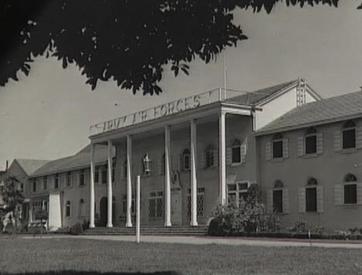

The 18th AAF Base Unit (Motion Picture Unit), originally known as the First Motion Picture Unit, Army Air Forces, was the primary film production unit of the U.S. Army Air Forces (AAF) during World War II, and was the first military unit made up entirely of professionals from the film industry. It produced more than 400 propaganda and training films, which were notable for being informative as well as entertaining.[1][2] Films for which the unit is known include Resisting Enemy Interrogation, Memphis Belle: A Story of a Flying Fortress and The Last Bomb—all of which were released in theatres. Veteran actors such as Clark Gable, William Holden, Clayton Moore, Ronald Reagan, and DeForest Kelley, and directors such as John Sturges served with the 18th AAF Base Unit. The unit also produced training films and trained combat cameramen.
First Motion Picture Unit is also the eponymous title of a 1943 self-produced documentary about the unit narrated by radio and television announcer Ken Carpenter.[3]
When the United States entered World War II in December 1941, the Air Corps was a part of the Army, and motion picture production was the responsibility of the Army Signal Corps. USAAF Commanding General "Hap" Arnold believed that the formation of an independent film entity would help lead to the air service gaining its independence. At a meeting in March 1942, General Arnold commissioned [Warner Bros.](https://en.wikipedia.org/wiki/Warner_Bros.) head Jack L. Warner, producer Hal Wallis and scriptwriter Owen Crump to create the unit. Warner was made lieutenant colonel and Crump a captain but Wallis, who was then in production with Casablanca, did not accept the offer. Of immediate concern was a critical shortage of pilots and recruits. Arnold told Warner he needed 100,000 pilots, and contracted with Warner Bros. to produce and release a recruitment film, which would come to be known as *Winning Your Wings.*[4][5]
Winning Your Wings was directed by John Huston and Owen Crump, and featured James Stewart as a dashing pilot. Stewart's virile, masculine portrayal changed the public perception of military aviators.[4][6] The film, which was completed in only two weeks, was a great success and according to General Arnold was pivotal in recruiting 100,000 pilots.[1][7] Warner Bros. would produce several films prior to the activation of the First Motion Picture Unit, most notably Men of the Sky, Beyond the Line of Duty and The Rear Gunner.[4]
The success of Winning Your Wings created a demand for training and recruitment films which proved difficult for Warner Bros. to fulfill.[6] Jack Warner began the process of developing the organizational structure for an independent motion picture unit.[4] The dual mission of the unit was to produce training and morale films, and to train combat cameramen.[8] The ranks were to be filled with film industry professionals, the first time in history such a unit would be raised.[1]
The Hal Roach Studios; leased by Headquarters, 18th AAF Base Unit

On 1 July 1942, the First Motion Picture Unit became an active unit of the USAAF. Key personnel that formed the initial roster included Lt. Col. Warner as commanding officer, Capt. Crump, Capt. Knox Manning, 2nd Lt. Edwin Gilbert, 2nd Lt. Ronald Reagan and Cpl. Oren W. Haglund. At first the unit operated out of offices at Warner Bros. in Burbank, California, and then moved to Vitagraph Studios in Hollywood. Vitagraph, however, had not been maintained and proved to be inadequate for movie production on a scale required by the unit.[4] By sheer happenstance Crump came upon the Hal Roach Studios in Culver City. According to writer Mark Betancourt, the facility was perfect:[6]
The studio had everything the motion picture unit needed: six warehouse-size sound stages, prop rooms, editing bays, costume and makeup departments, even an outdoor set made to look like a city street ... The lot comprised 14 acres and dozens of buildings ...
In October the unit moved into Hal Roach Studios, which the men nicknamed "Fort Roach."[9] Warner returned to running his company,[5]: 110 and Lt. Col. Paul Mantz took over as commanding officer.[8]
Capt. Ronald Reagan at Fort Roach

Personnel assigned to the 18th AAF Base Unit included some of the most well known film professionals of the day, as well as filmmakers who would have great success after the war. Actors such as Clark Gable, William Holden and Alan Ladd, and directors including Richard L. Bare and John Sturges served with the unit.[9] Future president Ronald Reagan, who transferred from the cavalry reserve, was a captain in the unit. He was the personnel officer and was responsible for maintaining personnel files and orienting new recruits to the operational aspects of Fort Roach. Later he was appointed adjutant.[1] Like the other notable actors Reagan appeared in the films produced by the unit, but to avoid distracting the audience they were eventually relegated to narrating the films.[6]
The 18th AAF Base Unit was unique in comparison to other military units in the methods employed to obtain recruits. Many members were well into middle age and unsuitable for combat duty. Few of the men in the unit were ever sent to a war zone. Due to its special mission, the unit was able to bypass the normal recruiting channels and was empowered to draft directly.[9][10] Basic Training was not as rigorous as that experienced by most servicemen. According to former unit member Howard Landres, Basic Training was mandatory, "but it wasn’t the basic-basic."[6]
Military decorum at Fort Roach was less formal than in most units. Saluting was optional, and unit members called each other by their first names. Hal Roach Studios did not have barracks, so commuting from home was commonplace. Men from out of the area were billeted at nearby Page Military Academy.[6]